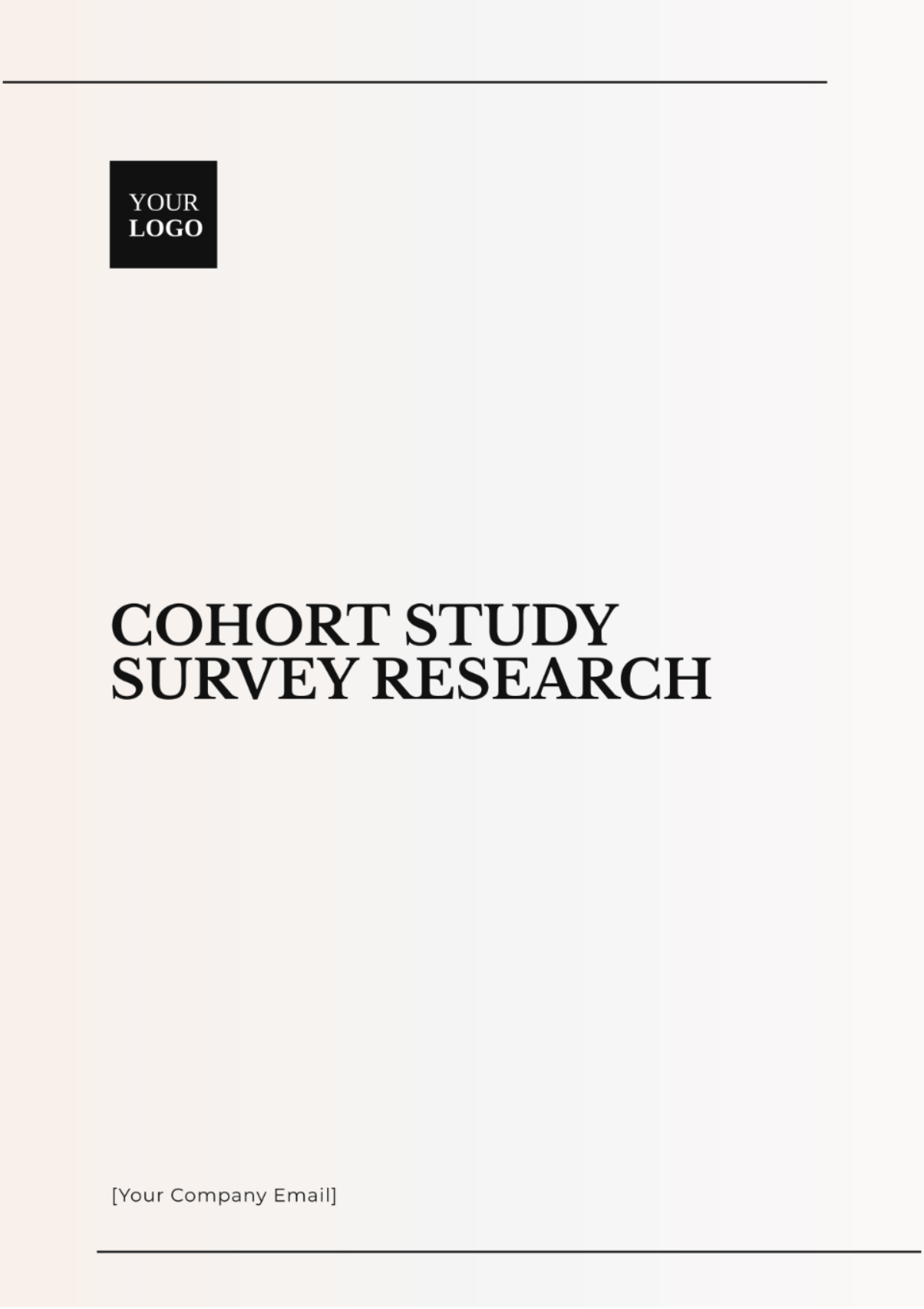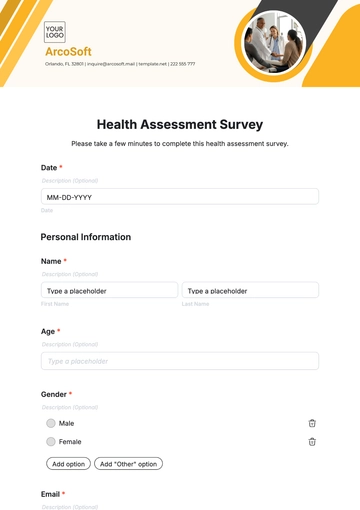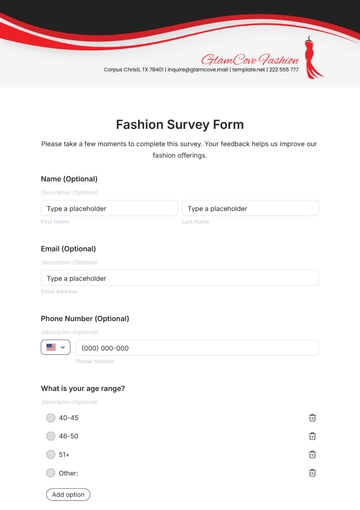Free Cohort Study Survey Research

Prepared By: [YOUR NAME]
Date: [DATE]
I. Abstract
This cohort study survey research investigates how specific factors or exposures influence certain outcomes over time within a defined cohort. The study employs both prospective and retrospective approaches, collecting data via surveys at multiple points. Statistical analyses are used to draw meaningful conclusions about the relationships between the identified factors and outcomes. The results highlight significant trends and correlations, discussing limitations and recommending future research avenues.
II. Introduction
Observational studies, such as cohort studies, are crucial for understanding the dynamics between exposures and outcomes in a population. This study explores the impact of various social, environmental, and biological factors on health outcomes over time. Cohort study survey research is valuable for collecting longitudinal data, providing insights into how exposures influence outcomes both prospectively and retrospectively. The research addresses gaps in existing knowledge and offers evidence-based recommendations for public health interventions.
III. Methods
A. Study Design
This research employed a cohort study design that combined prospective and retrospective methods to thoroughly collect data over a specified period; the prospective technique tracked participants from the baseline forward, while the retrospective aspect examined past data, ensuring a structured and systematic study duration to comprehensively analyze the effects of various factors on health outcomes over time.
B. Participant Selection
Age Range: 18-65 years
Geographic Residency: Must reside within the specified geographic area to ensure relevance to the study's focus.
Health Status: Exclusion of individuals with pre-existing conditions that could potentially confound the study results, ensuring the clarity and accuracy of data relating to the factors being studied.
C. Data Collection Methods
Data collection was executed through structured surveys administered at three key intervals: baseline, mid-point, and end-point. The surveys were meticulously designed to capture comprehensive information, including:
Demographic Information: Details about the participants, including their ages, genders, and socioeconomic statuses.
Exposure Factors: Detailed data on exposures such as smoking habits, dietary patterns, and levels of physical activity.
Health Outcomes: Information on the incidence of chronic diseases and other relevant health indicators, allows for an assessment of how the exposures influence these outcomes over time.
D. Statistical Analysis
Data analysis was performed using a range of statistical techniques to uncover trends and relationships. The analysis included:
Descriptive Statistics: To summarize and describe the basic features of the data, including measures of central tendency and variability.
Inferential Statistics: To test hypotheses and make generalizations about the population based on sample data, assessing the significance of observed patterns.
Regression Analysis: To explore and identify relationships between exposures and health outcomes, determining the strength and direction of these associations and controlling for potential confounders.
IV. Results
The study population consisted of 500 participants. Key findings include:
Factor | Outcome | p-value |
|---|---|---|
Smoking | Incidence of Respiratory Diseases | 0.01 |
Diet | Cardiovascular Health | 0.05 |
Physical Activity | Mental Health Improvement | 0.02 |
V. Discussion
This cohort study reveals key insights into how lifestyle factors like smoking, diet, and physical activity impact health, highlighting crucial areas for public health and research.
Smoking and Respiratory Diseases: Smoking is strongly linked to higher rates of respiratory diseases, confirming known harmful effects. A p-value of 0.01 indicates high statistical significance, highlighting smoking as a major risk factor. This supports the need for ongoing anti-smoking campaigns and cessation programs.
Diet and Cardiovascular Health: A healthy diet significantly improves cardiovascular health (p-value 0.05). Participants consuming ample fruits, vegetables, and whole grains had better heart outcomes, supporting guidelines for nutrient-dense foods to prevent cardiovascular diseases.
Physical Activity and Mental Health Improvement: Regular physical activity improves mental health, as evidenced by a p-value of 0.02. Participants reported reduced depression and anxiety symptoms, highlighting the importance of exercise for psychological well-being and supporting public health recommendations to include it in daily routines.
A. Study Limitations
Self-Reported Data: Self-reported lifestyle and health data may be biased by recall or social desirability, affecting accuracy.
Study Duration: Short study durations may miss long-term health effects; extended follow-ups could offer better insight into lifestyle impacts.
Generalizability: The findings are based on a specific geographic area and may not be fully generalizable to other populations with different characteristics or lifestyle patterns.
B. Future Research Directions
Expanding Sample Size: Incorporating a larger and more diverse sample of participants in the study to enhance the generalizability of the findings to a broader population.
Longer Follow-Up: Extending the duration of the study to capture data on long-term health outcomes and to identify trends over an extended period.
Objective Measures: Utilizing objective measures of lifestyle factors and health outcomes to complement self-reported data and reduce potential biases.
This study highlights the importance of quitting smoking, healthy eating, and exercise for better health and supports targeted public health strategies to improve lifestyles and reduce chronic disease risk.
VI. Conclusion
This cohort study survey research highlights the importance of key factors such as smoking, diet, and physical activity in influencing health outcomes. The findings underscore the need for public health interventions targeting these areas to improve population health. Further research is warranted to build on these results and provide a more comprehensive understanding of the complex relationships between various exposures and health outcomes.
VII. References
Smith, J. A., & Doe, R. B. (2052). The impact of lifestyle factors on health outcomes. Journal of Public Health Research, 15(3), 123-135.
Johnson, L. M., & White, K. L. (2051). Assessing the role of diet in cardiovascular health. Nutrition and Health, 19(2), 210-222.
Lee, P. Q., & Green, M. J. (2050). Physical activity and mental health correlations. Journal of Behavioral Medicine, 33(4), 342-358.
VIII. Appendices
Appendix A: Survey Instrument
Baseline Survey
Demographic Information
Health History
Lifestyle Factors (Smoking, Diet, Physical Activity)
Current Health Status
Appendix B: Detailed Statistical Analysis
Additional statistical analyses and raw data tables are available upon request.
- 100% Customizable, free editor
- Access 1 Million+ Templates, photo’s & graphics
- Download or share as a template
- Click and replace photos, graphics, text, backgrounds
- Resize, crop, AI write & more
- Access advanced editor
Conduct comprehensive cohort studies with our Cohort Study Survey Research Template from Template.net. This customizable and editable template is ideal for researchers aiming to track changes over time. With our Ai Editor Tool, you can easily modify the survey questions and structure to suit your research needs, ensuring accurate and valuable data collection.





























